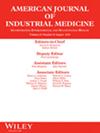Ethylene Oxide Measurements From OSHA Workplace Investigations: Patterns in Exposure by Industry, Occupation, and Over Time
Abstract
Background
Ethylene oxide (EtO) is an occupational carcinogen; however, contemporary exposure scenarios in US workplaces are not well characterized within the literature. We aim to describe EtO exposure trends in the US workplace using historical data from the Occupational Safety and Health Administration (OSHA) Chemical Exposure Health Database and the OSHA Information System.
Method
We collated and analyzed air sampling data collected between 1979 and 2020 to characterize exposures across key industries and occupations. We evaluated exposure by industry and occupational category, examined changes in exposures over time, and quantified the proportion of samples that exceeded existing occupational exposure limits.
Results
Exposures generally decreased over time. However, the magnitude and pattern of reductions were not consistent across industries. Within the aggregated dataset, approximately 46% of samples exceeded the National Institute for Occupational Safety and Health recommended exposure limit (NIOSH REL) of 0.1 parts per million (ppm), and approximately 18% of samples exceeded the OSHA permissible exposure limit (PEL) of 1 ppm. 70% of samples collected from industrial sterilization workplaces exceeded the NIOSH REL. Exposure data was limited between 2000 and 2020, most notably for the health services and chemical manufacturing industries.
Conclusions
Contemporary EtO exposures for key industries and occupational categories are poorly characterized. Still, exposures in the industrial sterilization industry appear higher than in other industries and have proportionally declined the least over time. Additional exposure assessment research and further efforts in occupational risk assessment are important to better understand the health burdens of workers exposed to EtO.


 求助内容:
求助内容: 应助结果提醒方式:
应助结果提醒方式:


